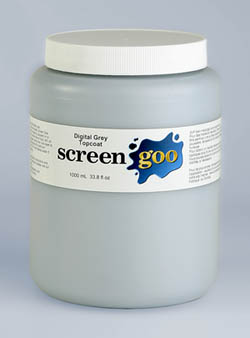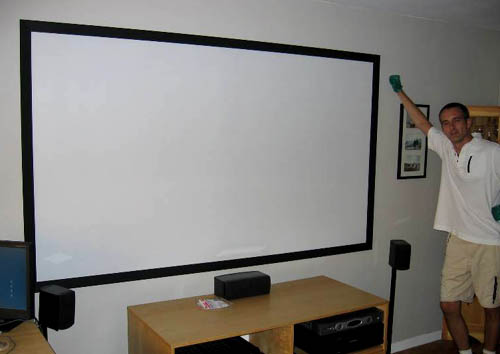Goo Systems Digital Grey ScreenGoo Projection Screen Paint Review
By Chris Boylan
Where There is a Wall, There is a Way
The Big Picture sensation is sweeping the nation - Front Projection Television Big Picture that is. Front projection television (FPTV) is really the only cost effective way to get a high quality image measured in FEET instead of inches so you can bring that true movie theater experience to your home. But many people who purchase home theater front projectors simply point them at a wall and believe that this is "good enough." I'm here to tell you friends, that this is just not the case.
Most folks think that a white, or off-white wall is a pretty good surface to reflect a projector's image. But in fact, standard latex paint, particularly in a matte or eggshell finish, can significantly decrease the usable light output of your projector, plus off-white and even white colored walls can seriously screw up your contrast ratio and color accuracy. And when you point your projector at a wall, with no border around the image area, you lose perceived contrast. The whites don't look as bright, nor the blacks as dark because the image has no boundary to set it apart from the background wall. And finally, most walls (with the exception of new construction) have defects. Whether you have major cracks in the plaster or painted-over nail-holes, defects in the wall's surface can and will impact your picture's uniformity.

One Liter of Screen Goo Digital Grey can cover up to 50 square feet if rolled, or 40 square feet if sprayed.
Buy vs. Build - the Endless Dilemma
So how do you correct these problems? Well, the simplest solution is to buy a good projection screen. Depending on whether you have a CRT (tube) projector, or a fixed panel "micro-display device" projector (e.g., LCD, DLP, LCOS, SXRD, D-ILA), the ideal color and reflectivity or "gain" of the screen will vary. But you can generally find decent quality home theater screens from companies such as Stewart, Carada and Da-Lite with prices that range anywhere from about $500 to $5,000, depending on brand, size, style, options and screen composition.
For those home theater fans on a limited budget, or those who need or want really large screens, which may be cost-prohibitive to buy, there is another option - painting your own screen. Of course, you'll need to be comfortable with a spray gun or a paint roller, or at least have a friend who fits this description. If you've got the patience and the skills, then the potential rewards of your efforts can be exceptional for a fairly nominal investment. But if standard latex paint is not the best choice, then what is? This is where Goo Systems comes in.
Goo It To Me One More Time
Goo Systems, a paint manufacturer based in Canada, has designed a special highly reflective acrylic paint called Screen Goo, formulated specifically for use in front projection installations. Years of research and development have gone into the formula to get the best results while maintaining a fairly simple application process. The process involves applying both a base coat and a top coat, with the specific paint formula matched to the desired screen size, ambient lighting conditions and most importantly, the technology of the projector. Screen Goo colors include "CRT White," "Digital Gray," "Digital Grey Lite," and "Ultra Grey." The Goo Systems web site features a
product selector which is extremely useful in helping you make the right color choice for your specific projector as well as calculating how much Goo you'll need for the job.
For our purposes (Sanyo PLV-Z2 LCD projector with a 98 inch diagonal screen length and subdued lighting), the recommendation at the time was one liter each of Digital Grey base coat and top coat at a cost of around $170 US including shipping. Using light grey, as opposed to white, compensates for most digital projectors' inability to produce true black. Don't worry, "Digital Grey" looks perfectly white when actually viewing content on the screen. The gain of the Digital Grey coating is a maximum of 1.2 directly on axis, tapering off to around 0.8 forty-five degrees off axis. Goo has recently introduced "Digital Grey Lite" which provides a gain of up to 1.4 on axis, in case you need a larger screen, or you're dealing with higher ambient light.
In addition to the Screen Goo itself, we needed rollers, spackling compound and masking tape, plus wood moulding, industrial Velcro and flat black paint for the home-made frame. This added approximately $75 for a total of just under $250 for supplies for the project.
Once everything arrived, our resident paint-meister Adam Clem prepared the wall, filling in cracks and smoothing out defects, applied the base coat, then the top coat via rollers, then assembled, painted and mounted the black wood frame. The full construction process is revealed in our companion article "
How To Paint your own Projection Screen." Once the Goo had dried, we calibrated the picture using the "Avia Guide to Home Theater" DVD, then sat down for some serious watching. The results were not subtle.

Adam Clem, screen painter extraordinaire, poses with the finished product - a tabula rasa to be filled with pretty (moving) pictures.
On any program material, including High Definition documentaries and nature shows on Discovery HD and PBS-HD, and DVD movies like "Gladiator," "The Fifth Element" and "The Lord of the Rings" (all three parts), the picture, which had been pretty good even on the old wall, assumed a new level of realism and accuracy that greatly enhanced our enjoyment.
"It's like, how much more black could this be? and the answer is none. None more black." - Nigel Tufnel, "Spinal Tap"
Blacks which had been medium to dark grey were now much closer to real black. Reds and greens which had been slightly washed out became more vivid and the contrast between light and dark parts of the image became much more pronounced. There were no visible hotspots and walking from side to side, even to 60 degrees off-axis, exhibited a very subtle degradation of overall brightness.
The only drawback of having a screen this good is that limitations in the source material now became slightly more evident. The new "Gladiator Extended Edition" DVD, which includes a high-quality enhanced digital transfer exhibited visible scan lines that the improved resolution of the Goo Screen allowed us to see where they had been less visible in the past. These scan lines were not visible on HD source material, only on DVD and some other standard definition content. Chances are that a good video scaler would improve or eliminate this effect as would reducing the screen size (but that ain't gonna happen!). And in any case, we surely can't blame the screen for illuminating flaws in the source material or source components!
If you're still pointing your front projector at a plain old wall, then stop reading
now and get yourself some Goo! In addition to the raw paint, they also sell "Screen Kits" which include the rollers and trays so you'll have just about everything you'll need (minus the frame which you can assemble out of your choice of moulding, or even just flat black paint, applied directly to the wall). And if you're not much of a painter, then you can find a list of local experts who have experience painting Goo screens here on Goo Systems' "
Resources Page."
Get up, and get Goo-ing! You'll be glad you did.
Where to Buy Screen Goo Online:
Manufacturer's Contact Information:
Goo Systems
4 Harvey Street
Kingston ON - Canada
K7K 6A9
toll free: (888) 541-0299
phone: (613) 541-0299
fax: (613) 541-1765
web: www.goosystems.com

